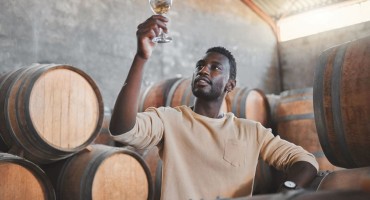The Art of Wine Tasting: A Beginner's Guide

If you're new to the world of wine, you may find yourself wondering what wine tasting is all about. This method of evaluating the quality of wine is popular with wine connoisseurs and industry experts, as well as regular consumers.
Why Try Wine Tasting?
You've probably noticed that there are significant differences between wines. Even within a particular variety of wine, such as Chardonnay, there can be a lot of variation. For instance, one bottle may taste full-bodied and oaky, while another is light and fruity. These differences are what give wines their own personalities, and they are also the reason for wine tasting.
Who Tastes Wine?
Anyone can be involved in a wine tasting. Some experts taste wines in order to write reviews, buy wines for a store or restaurant, or rate particular vintages, but regular people also get to participate in this fun sensory experience. Many wineries offer tasting tours, which give visitors the chance to try many of their best-selling varieties. In recent years, wine tasting parties have also become a popular amusement.
Evaluating Wines
To taste wine, use the detailed process below:
- Examine the wine in the glass. How does light filter through the wine? Does it cling to the edge of the glass? What colors do you notice?
- Smell the wine. Make note of any aromas. Is it fruity or floral? Does it have a sharp or tangy scent?
- Swirl the glass and sniff again. Swirling will aerate the wine and release new aromas. Notice any changes after swirling.
- Take a sip of the wine and evaluate how the wine feels and tastes. Does it seem rich? Is it light and crisp?
- After swallowing the wine, consider the aftertaste. Does the flavor linger? How does it change over time?
Wine Tasting Tips for Beginners
If you'll be participating in a wine tasting, it can be helpful to understand the etiquette and terminology involved.
- Pour only a small amount of wine into your glass. You should take enough for one or two sips, leaving the rest for other people.
- Take your time with each wine. Examine it in the glass and try to describe its aroma. When you taste it, don't swallow it immediately. Hold it in your mouth for a few moments to get a sense of its personality.
- If there is a spittoon, you might consider spitting out the wine. This is polite behavior at a wine tasting since it allows you to taste many wines without worrying about alcohol affecting your judgment.
- If a wine is not to your taste, it's okay to discreetly pour the remainder in the spittoon once you've tasted it.
- Cleanse your palate between wines by eating a piece of bread or crackers; many tasting rooms have palate cleansers available.
- If you're tasting at wineries, check the website or call before going. Some wineries offer tastings by appointment only; others accept walk-ins.
- When you're tasting at wineries, you can expect to pay a tasting fee to taste a flight of wines. Tasting fees will vary depending on the number and quality of the wines you taste.
- Familiarize yourself with terms used for describing the wines you taste.
- Taste wines in the following order: sparkling wines, light white, bold white, rosé, light red, bold red, sweet and/or fortified.
- Don't stress; there are no right or wrong answers here. Tasting for beginners is a great way to learn about different wines and find the types of wines that you enjoy.
- If you're at a winery or wine shop, don't be afraid to ask questions.
Wine Tasting Parties
If you love wine, throwing a wine tasting party can be a great way to share the tasting experience with friends. These parties are usually very casual and fun. These tips can help you plan:
- Explain the tasting process to your guests so they will feel comfortable and have a good time.
- Have plenty of glassware available. If you don't have enough wine glasses for everyone to get a fresh one for each bottle, keep a pitcher of water handy for rinsing.
- Serve a variety of cheese and crackers, so guests can see how the wine pairs with different flavors and cleanse their palates between wines.
- Give guests scorecards so they can rate the wines according to their preferences.
The Restaurant Wine Tasting Ritual
When you order a bottle of wine in a restaurant, you'll likely experience the following:
- The server shows you the bottle of wine. Check the label for the name, varietal, and vintage to ensure it is the bottle of wine you have ordered.
- Next, the server removes the cork. If they hand it to you, there's no need to sniff it. Instead, touch the tip of the cork that was in the wine to make sure it is moist and not crumbled. Place the cork on the table.
- Now, the server pours a small amount in your glass. Look at the wine's color and check for cloudiness or sediment by holding the glass up to the light. Swirl, sniff, and taste. Here, you are tasting for off flavors or aromas that may indicate the wine has spoiled, such as a rotten egg smell, a vinegary taste, or a musty smell or flavor. If all is well, give the server a nod and he or she will pour the wine. If there are off flavors, tell the server the wine tastes off. He or she will bring you a new bottle, and the ritual will begin again.
The art of wine tasting is a captivating journey that unveils the diverse personalities of wines, allowing beginners to explore and appreciate the nuances of this beloved beverage. By engaging the senses, embracing the process, and immersing oneself in the world of flavors and aromas, wine enthusiasts can embark on a delightful adventure of discovery. Whether participating in tastings, hosting wine soirées, or indulging in restaurant experiences, the beginner's guide to wine tasting provides a solid foundation for anyone seeking to enhance their understanding and enjoyment of this timeless art form. So raise a glass, savor the complexities, and let the journey into the world of wine tasting begin. Cheers!
FAQ
What is wine tasting?
Wine tasting is a method of evaluating the quality and characteristics of different wines by using the senses of sight, smell, and taste. It involves observing the wine's appearance, noting its aromas, and evaluating its taste and mouthfeel.
Who can participate in wine tasting?
Anyone can participate in wine tasting, including both experts and regular consumers. Wine enthusiasts, connoisseurs, industry experts, and even beginners can engage in this sensory experience. Many wineries offer tasting tours, and wine tasting parties have also gained popularity.
What is the process of wine tasting?
The process of wine tasting involves several steps:
Examine the wine's appearance by observing its color and clarity.
Smell the wine to identify its aromas and determine if they are fruity, floral, or have other characteristics. Swirl the glass to release additional aromas and observe any changes.
Take a sip and evaluate the taste and mouthfeel, noting its richness or lightness.
Consider the aftertaste and how the flavor evolves over time.
What are some tips for beginners in wine tasting?
Here are some tips for beginners in wine tasting:
- Pour a small amount of wine into the glass and take your time with each wine.
- Observe the wine's appearance and describe its aroma.
- Consider using a spittoon to spit out the wine if available, to avoid the effects of alcohol.
- Cleanse your palate between wines by eating bread or crackers.
- Familiarize yourself with wine terminology and taste wines in a recommended order.
- Remember that there are no right or wrong answers when it comes to personal taste preferences.
- Feel free to ask questions and seek guidance from winery staff or experts.
How can I host a wine tasting party?
Hosting a wine tasting party can be a fun experience. Here are some tips:
- Explain the tasting process to your guests and ensure they feel comfortable.
- Provide enough glassware and offer water for rinsing glasses.
- Serve a variety of cheese and crackers to pair with the wines and cleanse palates.
- Consider giving guests scorecards to rate the wines based on their preferences.










